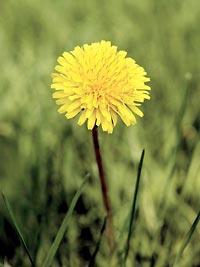Before you begin spraying, know how weed killers do their job

Now that the weather has warmed up, television, newspaper and magazine ads are filled with plugs for weed killers. There's so many that you might get to wondering about how these herbicides work. How do they know to kill the weeds and not the lawn?
Interesting stuff, these weed-killing chemicals, for they are not as urbane and refined as you might think.
The way they work is to interfere with growth, either by blocking photosynthesis and protein production or destroying or inhibiting root formation.
Herbicides disrupt plant growth, so they are not considered as dangerous to people as pesticides are, says Jeff Gillman, associate professor in the department of horticultural science at the University of Minnesota and author of "The Truth About Garden Remedies" (Timber Press, $19.95). The thinking behind this theory is that the human body has little in common with plants, unlike the parts of our physiology that we share with bugs such as bloodstreams, brains and nervous systems.
Still, you should use chemicals in your yard with caution.
• Put pets indoors.
• Always wear long sleeves, gloves and goggles.
• Read the label to find out how long you must stay out of the treated area.
Herbicides will kill plants — some you didn't intend to kill.
They also are not so hot for the environment. Some break down in the soil in just a few days, while others linger for many months or even years. They may leach into the root systems of nearby plants and trickle down to the water table. Don't forget that all water finds its way to the ocean, and there are plants out there in the deep blue sea.
Herbicides aren't the only weapon to fight weeds. Mulch your garden beds to smother weeds and promote a healthy lawn so interlopers won't have a chance.
Even so, as a last resort there may be a time or two when you get overrun with dandelions and you will want to resort to chemicals. As you stroll the herbicide isle, remember that not all weed killers are created equal. Here are a few label descriptives you should know:
Herbicide terms
Post-emergent: These chemicals are applied to leafy areas of plants that are green and actively growing.
Pre-emergent: These chemicals are applied to soil areas before plants emerge. The weed is either winter or summer dormant with no top growth at the time, or still in the seed stage.
Monocot: Think strappy leaves. "Monocot" describes single-cotyledon plants such as lawn grass, weed grass, ornamental grass, corn, bamboo, iris, lilies and orchids. This is an important term to know if you are shopping for selective types of herbicide.
Cotyledon: Cotyledons are those weird first "leaves" that pop above the ground when a seed germinates. Cotyledons are not true leaves, but food storage systems that help the plant until the true leaves appear. There are two cotyledons for dicot plants, and one cotyledon for monocot plants.
Dicot: Double cotyledon plants include everything on the planet except the few listed above. There are herbicides designed just for dicots.
Selective herbicides: They're designed to kill dicots or monocots, but not both.
Nonselective herbicides: They're designed to kill all plants.
Total vegetation herbicides: They not only kill all plants but prevent them from growing in a given area for up to a year.
Here's how the herbicides work:
Post-emergent, nonselective
Glyphosphate is a postemergent herbicide that works like an antibiotic. Antibiotics destroy enzymes in bacteria that make you ill. Once the enzyme is destroyed, the whole germ cell dies.
Glyphosphate, usually sold as Roundup, works the same way by destroying a critical plant enzyme, EPSP synthase. Once the enzyme is destroyed, protein production stops and plant cells die.
This herbicide works best on warm, growing season days.
Because it's nonselective, it kills all plants it comes in contact with. On a windy day, drifting spray can unintentionally kill plants nearby. Roses are especially vulnerable.
Pre-emergent, selective
Corn gluten is an example of a pre-emergent herbicide. It contains a naturally occurring chemical that corn produces to prevent other species from growing nearby, thereby eliminating competition.
This natural preventive works on lawn weeds by providing a barrier on the soil surface that discourages weed seeds from germinating. It works best on leafy dicots such as oxalis and dandelion. If used in the correct dosage, it will not harm monocots such as lawn grass.
Broadleaf, selective
Broadleaf weed killers are selective herbicides that work in lawns by targeting dicots that are actively growing while not harming the monocots such as lawn grass. The most common broadleaf weed killer is 2,4-D also known as Trimec.
2,4-D is an auxin or plant hormone that, when applied to the leaf area, simply confuses the plant to death. When auxin, the hormone that makes plants grow, is sprayed over the entire plant, the plant becomes deformed, then dies.
Grass killers, selective
Fluazifop is the active ingredient in grass killers, working in the opposite way as broadleaf weed killers by targeting the monocots. Fluazifop kills weed grasses in flower beds.